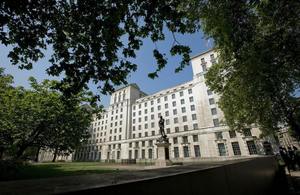Co-operation bringing stable government to Helmand
Civilian and military teams are working together in Afghanistan to bring stable government to the area. In sun-baked Helmand, a quiet revolution has been taking place. Report by Joanna Shayer.

At dusk in Nad ‘Ali, a civilian district stabilisation advisor is briefing his uniformed colleagues from the Military Stabilisation Support Group. Welcome to a new style of civilian-military working.
The relationship between the Stabilisation Unit, which is ‘owned’ by the Department for International Development (DFID), the Foreign and Commonwealth Office (FCO) and the MOD, and the Military Stabilisation Support Group is testament to the success of the cross-governmental and military approach.
Sheelagh Stewart, civilian head of the Stabilisation Unit, and Colonel Greville Bibby, commander of the military group, both talk of ‘a common understanding of goals, obstacles, issues and solutions on the ground’.
In Helmand, close co-operation, especially at district-level, has worked well. In each district, a five- or six-person Military Stabilisation Support Team works with the civilian stablisation advisors (StabAds).
There may also be civilian stabilisation advisors in forward operating bases. StabAds liaise with battle group commanders to set priorities, support the district governor and engage with the local population to deliver district stabilisation plans.
Sheelagh Stewart said:
In the past, military and civilians were not natural bedfellows in an operational environment. Indeed it’s fair to say that there used to be a degree of mutual suspicion. Now, they work as a seamless unit to deliver security and stabilisation in Helmand.
This shared mission is part and parcel of the way the government now works. Working together has simply become the accepted way, and it’s being emulated globally.
The Commander of the Military Stabilisation Support Group, Colonel Greville Bibby, who recently returned from nine months as Deputy Commander of Task Force Helmand, agreed.
The beauty of our comprehensive approach is that it enables government departments to bring their strengths together,” he said.
I experienced this first-hand in the Provincial Reconstruction Team in Lashkar Gah, where representatives from the FCO, DFID and MOD, as well as our coalition partners, worked brilliantly together with the provincial governor.
The Military Stabilisation Support Group delivers training to other servicemen and women and, increasingly, to civilians. They train and deploy Military Stabilisation Support Teams to Helmand and will expand to more than 400 personnel, of whom some 50 per cent will be reservists.
Civilians in the Stabilisation Unit’s pool of more than 1,000 experts include specialists in governance, communications, security and project management.
As well as Afghanistan, civilian experts are deployed in Kosovo, the Democratic Republic of Congo and Sudan.
MOD civil servant Amy White, recently returned from Helmand, said:
I absolutely love the Stabilisation Unit. You’ve got the political nuances and diplomatic approaches of the FCO, the speed and enthusiasm of MOD, and the development expertise and conflict assessment tools of DFID.
There’s nothing I have worked on that I haven’t found exciting, and I am lucky because there is so much to learn from colleagues.
Recently, experienced staff from both the military and civilian teams spent two days sharing their knowledge at the military training base in Ludgershall. The final day of the conference involved a planning exercise based on a fictitious scenario in Afghanistan.
Major Andy Hill was there. During one of several tours in Helmand, he worked in the Provincial Reconstruction Team as chief of operations during Op MOSHTARAK. It was an experience he reflected on with pride:
The highlight of my time was the role in Helmand. Then there was my involvement with Haiti in the wake of the earthquake. Although I didn’t go there, I helped co-ordinate the Stabilisation Unit’s response.
I am very privileged to be able to gain military and non-military perspectives on stabilisation. This post has allowed me to see a comprehensive approach in action, benefiting both defence and wider government,” he said.
This article by Joanna Shayer was first published in the September 2010 issue of Defence Focus - the magazine for everyone in Defence.
See Related Links to download a copy of the magazine and for more exclusive features on the Defence Focus Blog.